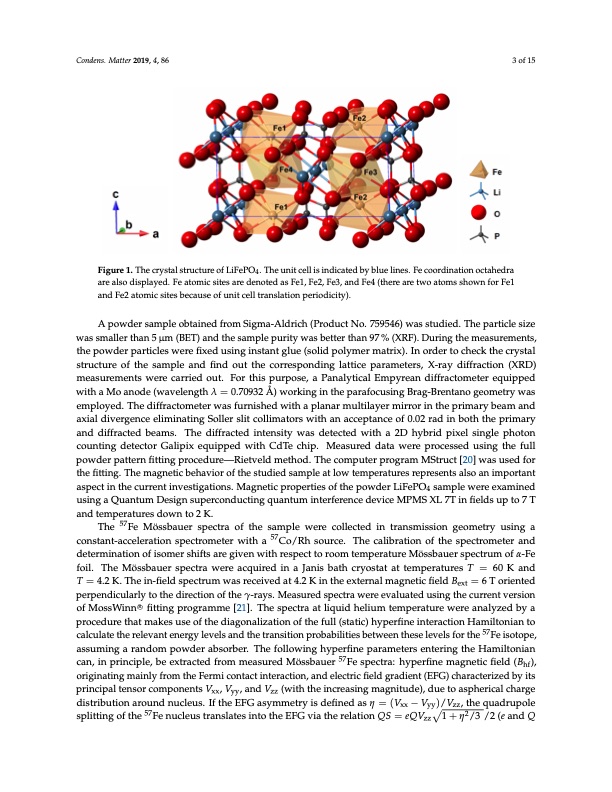
PDF Publication Title:
Text from PDF Page: 003
Condens. Matter 2019, 4, 86 3 of 15 Figure 1. The crystal structure of LiFePO4. The unit cell is indicated by blue lines. Fe coordination octahedra are also displayed. Fe atomic sites are denoted as Fe1, Fe2, Fe3, and Fe4 (there are two atoms shown for Fe1 and Fe2 atomic sites because of unit cell translation periodicity). A powder sample obtained from Sigma-Aldrich (Product No. 759546) was studied. The particle size was smaller than 5 μm (BET) and the sample purity was better than 97 % (XRF). During the measurements, the powder particles were fixed using instant glue (solid polymer matrix). In order to check the crystal structure of the sample and find out the corresponding lattice parameters, X-ray diffraction (XRD) measurements were carried out. For this purpose, a Panalytical Empyrean diffractometer equipped with a Mo anode (wavelength λ = 0.70932 Å) working in the parafocusing Brag-Brentano geometry was employed. The diffractometer was furnished with a planar multilayer mirror in the primary beam and axial divergence eliminating Soller slit collimators with an acceptance of 0.02 rad in both the primary and diffracted beams. The diffracted intensity was detected with a 2D hybrid pixel single photon counting detector Galipix equipped with CdTe chip. Measured data were processed using the full powder pattern fitting procedure—Rietveld method. The computer program MStruct [20] was used for the fitting. The magnetic behavior of the studied sample at low temperatures represents also an important aspect in the current investigations. Magnetic properties of the powder LiFePO4 sample were examined using a Quantum Design superconducting quantum interference device MPMS XL 7T in fields up to 7 T and temperatures down to 2 K. The 57Fe Mössbauer spectra of the sample were collected in transmission geometry using a constant-acceleration spectrometer with a 57Co/Rh source. The calibration of the spectrometer and determination of isomer shifts are given with respect to room temperature Mössbauer spectrum of α-Fe foil. The Mössbauer spectra were acquired in a Janis bath cryostat at temperatures T = 60 K and T = 4.2 K. The in-field spectrum was received at 4.2 K in the external magnetic field Bext = 6 T oriented perpendicularly to the direction of the γ-rays. Measured spectra were evaluated using the current version of MossWinn⃝R fitting programme [21]. The spectra at liquid helium temperature were analyzed by a procedure that makes use of the diagonalization of the full (static) hyperfine interaction Hamiltonian to calculate the relevant energy levels and the transition probabilities between these levels for the 57Fe isotope, assuming a random powder absorber. The following hyperfine parameters entering the Hamiltonian can, in principle, be extracted from measured Mössbauer 57Fe spectra: hyperfine magnetic field (Bhf), originating mainly from the Fermi contact interaction, and electric field gradient (EFG) characterized by its principal tensor components Vxx, Vyy, and Vzz (with the increasing magnitude), due to aspherical charge distribution around nucleus. If the EFG asymmetry is defined as η = (Vxx − Vyy)/Vzz, the quadrupole splitting of the 57Fe nucleus translates into the EFG via the relation QS = eQVzz1 + η2/3 /2 (e and QPDF Image | Mossbauer Spectroscopy of Triphylite (LiFePO4) at Low Temperatures

PDF Search Title:
Mossbauer Spectroscopy of Triphylite (LiFePO4) at Low TemperaturesOriginal File Name Searched:
condensedmatter-04-00086.pdfDIY PDF Search: Google It | Yahoo | Bing
Sulfur Deposition on Carbon Nanofibers using Supercritical CO2 Sulfur Deposition on Carbon Nanofibers using Supercritical CO2. Gamma sulfur also known as mother of pearl sulfur and nacreous sulfur... More Info
CO2 Organic Rankine Cycle Experimenter Platform The supercritical CO2 phase change system is both a heat pump and organic rankine cycle which can be used for those purposes and as a supercritical extractor for advanced subcritical and supercritical extraction technology. Uses include producing nanoparticles, precious metal CO2 extraction, lithium battery recycling, and other applications... More Info
| CONTACT TEL: 608-238-6001 Email: greg@infinityturbine.com | RSS | AMP |